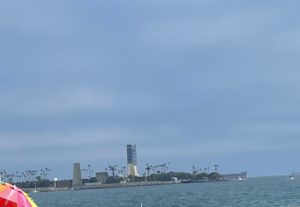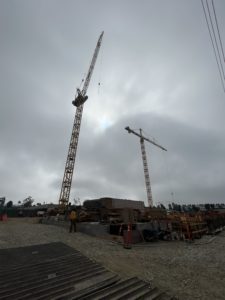When thinking of Los Angeles, what first comes to mind is glitz and glam. An image of Hollywood or dreamy beaches and high skylines. Before all this development, the Los Angeles oil drilling boom led to great wealth. Hidden Los Angeles Oil and Methane Drilling are the unfamiliar histories that gave way to developers. In the 1890s, oil Tycoon Edward Doheny struck gold by pumping 45 barrels daily. This changed Los Angeles from a population of 50 thousand to one million by 1930. Back in the 1950’s residents even brought up installing their own oil wells in their yards. While this didn’t happen, it is noted that Los Angeles sits on a large oil field. It wasn’t the end of oil rigging. In current times there are thousands of active wells in Los Angeles.
Skyline Shift
What makes it harder to recognize these derricks is the soundproofing, addition of waterfalls, tall trees, and the placement of attractive facades.

This isn’t the case for driving around neighborhoods such as Inglewood, which easily shows their many towers for oil. Los Angeles oil drilling is spread throughout the county. While some locations are residential, homeowners are paid if the pipes go under their property. This is a nice cushion that may cover one’s mortgage.
What is unfamiliar to many is that while the landscape has changed, some oil rigs are placed in plain sight, masquerading by windowless buildings. Driving through a cotton candy sunset along the Pacific Coast Highway, passengers may see little islands with buildings. These are not residential. The islands are oil derricks disguised to look pleasant. A commonly recognizable one is the exxonmobil islands near Santa Barbara. While the Island features tropical plants, the pipe is easily identifiable. Down south in Long Beach, many oil derricks also use buildings and trees to mask their purpose.
Metropolitan Disguises
These oil wells are not limited to coastal locations. There are oil wells within Los Angeles that are not easily identifiable. Back in the 1960’s Occidental Petroleum proposed disguising oil rigs to beautify the city. This was to welcome the growing population. Some oil wells are visible, as residents may call them Eiffel oil towers. The ones that are disguised happen to be throughout Los Angeles County.

Some notable Los Angeles oil drilling rigs that are hidden in plain sight include Packard Well in Mid-Wilshire. This is a large beige building, that does not have windows. From the outside, it disguises itself as a skyscraper. The Cardiff Tower in the Pico Robertson area is disguised as a synagogue. It holds forty oil wells, accessible via a movable derrick.
A movable derrick is a crane machine that is in use for drilling oil. Similar in operation, is the Tower of Hope which also uses movable derricks. This oil well is disguised as a tower with floral murals inside of a high school. Another area that hoists a site of oil rigging is the Beverly Center. This mall is next to a large building that looks like a wing of the mall. It does not have a roof, so from the parking garage looking down is how onlookers can recognize the machinery.
 Hidden Los Angeles Oil and Methane Drilling Angeles oil is no longer the main producer in the country. It is history to know that it once held a huge role in the development of the city. While oil extraction was a major source of wealth back in its day, Sway Features works to make construction safe with methane systems and through waterproofing membranes to ensure the chemicals left from wells don’t sneak back into our lives.
Hidden Los Angeles Oil and Methane Drilling Angeles oil is no longer the main producer in the country. It is history to know that it once held a huge role in the development of the city. While oil extraction was a major source of wealth back in its day, Sway Features works to make construction safe with methane systems and through waterproofing membranes to ensure the chemicals left from wells don’t sneak back into our lives.
